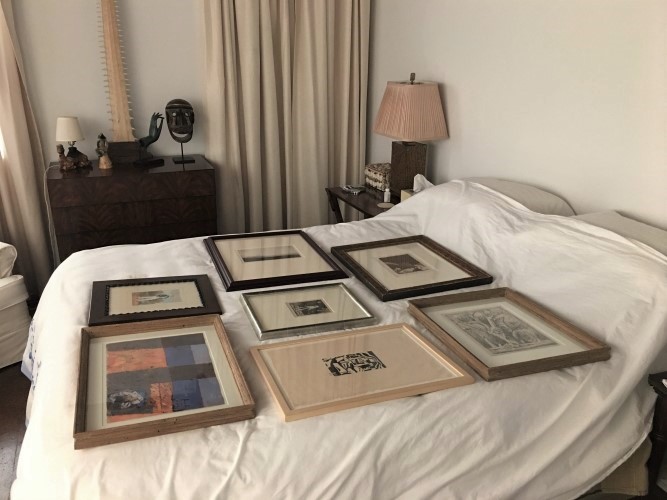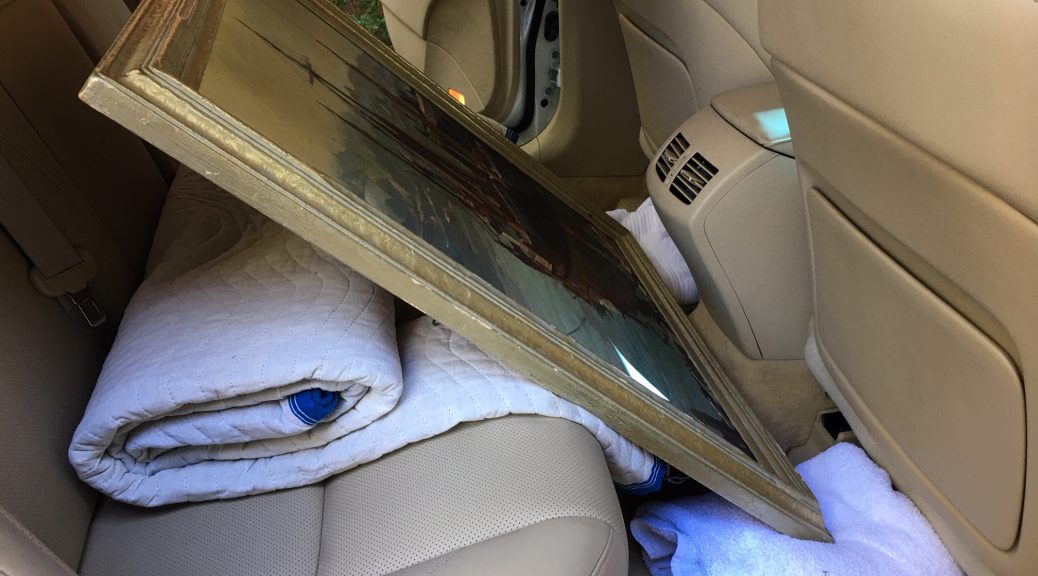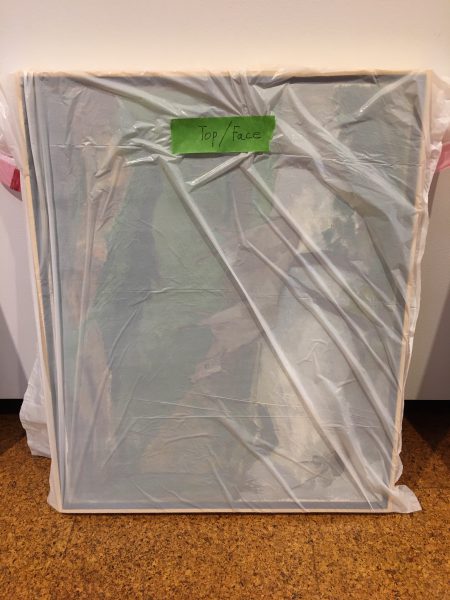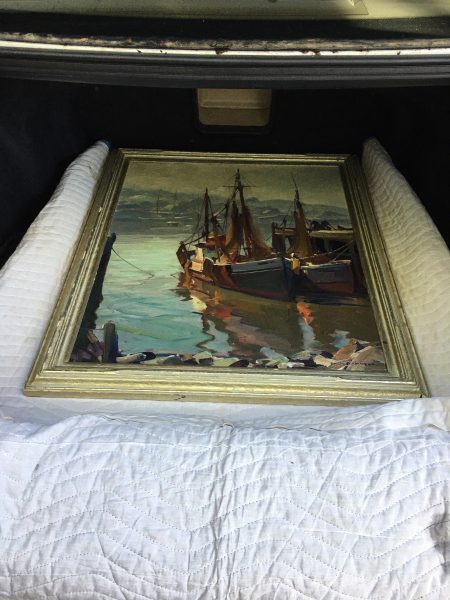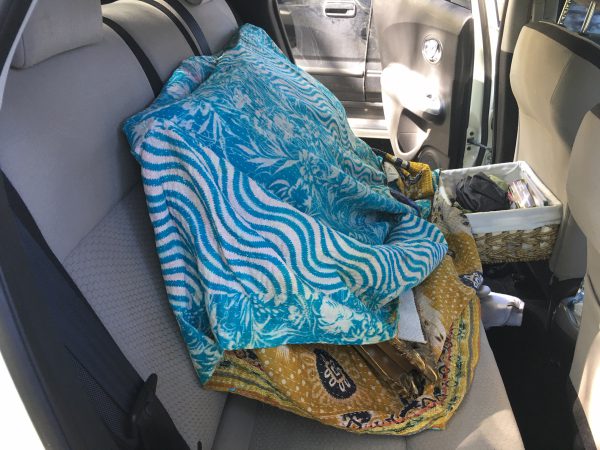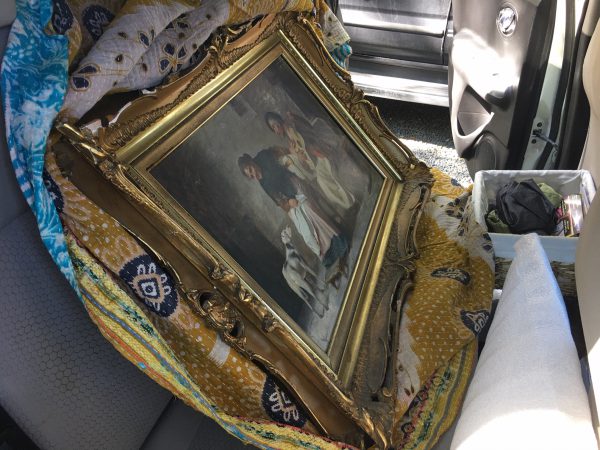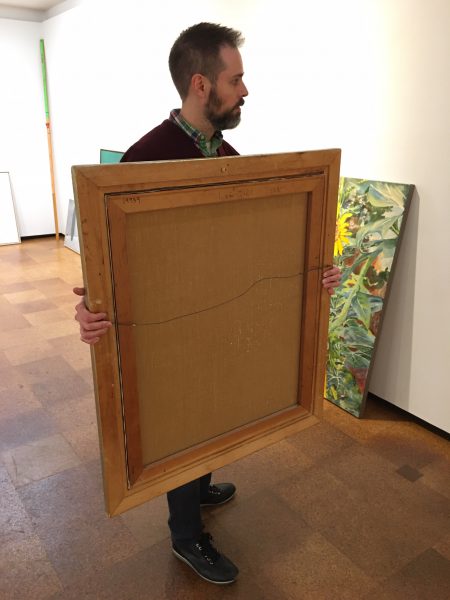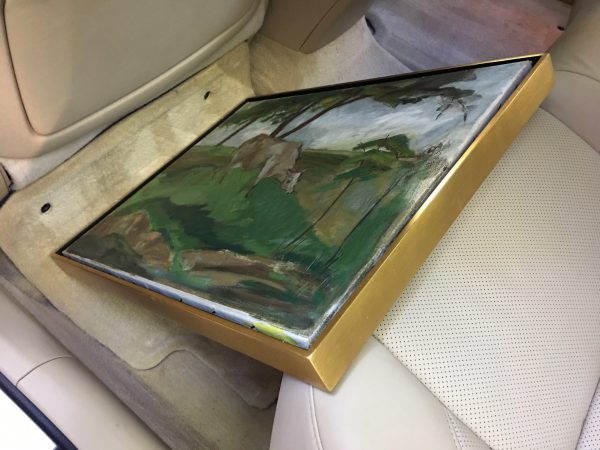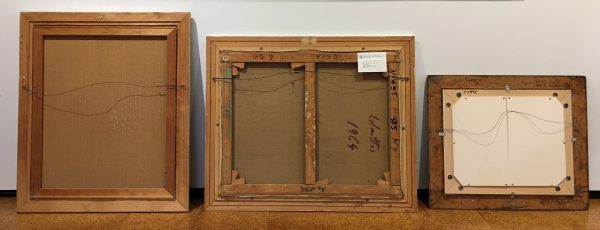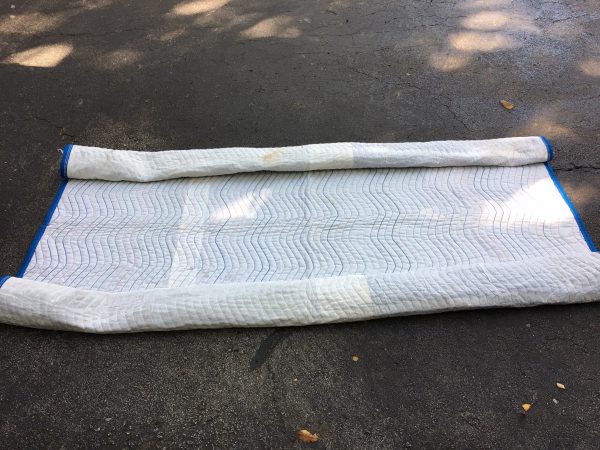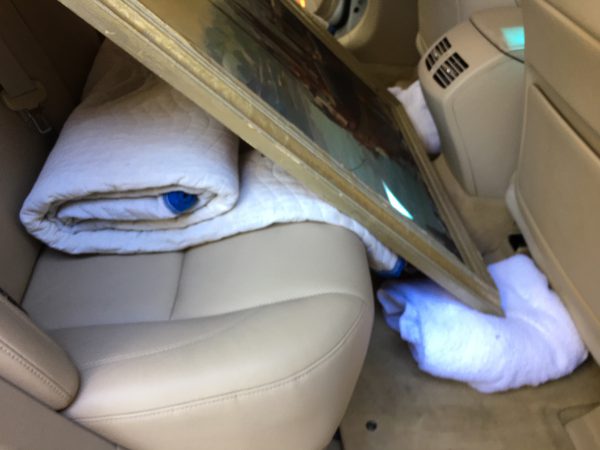So, you have decided to paint the living room. While the workers do their thing, you have determined that the furniture can be moved to the center of the room and be protected via drop cloth, but where and how should you temporarily store your art for the next two weeks while the paint dries? Temporarily Storing your Artwork, A Case Study will help you decide.
As with my post on transporting an artwork in your car, I will make suggestions on how to temporarily store artwork by safely stacking two-dimensional works against a wall using protective materials that would be found in your home or could be picked up at a local U-LINE, Lowes, or Home Depot. If you are lucky to live with museum quality works, you might want to call an art moving company to carefully pack and move them to a bonded climate-controlled storage facility and read no further. If your artworks are not of museum quality, carefully stacking them against a wall and providing protection at any points of contact can work just as well.
Deciding Where Your Artwork Should Be Stored
Choose a climate-controlled space to store your art. One of the best storage spaces might be a rarely used guest bedroom where the artworks are out of normal traffic patterns and the door can be shut to keep out roaming pets. A deadbolt lock installed on the door would also keep out wandering “guests.”
Since many homes these days have climate zoned spaces so you are not senselessly air conditioning rarely used areas, if the “guest bedroom” you are planning to use is not in a frequently used zone, be sure to adjust that zone’s temperature a day or two before you are planning to move the artwork. This will allow its temperature to normalize to the rest of the house and confirm that the HVAC equipment is working properly. Remember the main things to worry about are temperature, humidity, and airflow. The atmosphere of the storage space should be close to the living room they came out of.

Find a wall where the largest artwork you are storing will fit so its entire top frame edge is fully resting against it. If the artwork is not a work on paper and not hinged, it can be place in any orientation, so its smallest side should be leaning against the wall. If it is a glazed work on paper and/or hinged, it needs to always be kept upright. If you have many artworks, they can be divided into multiple stacks, especially if there is a lot of weight involved or a large size differential between artworks. It is often a good idea to group the works in general size categories, like large, medium, and small, and stack them accordingly.

If there is a bed in the room, place an old sheet over its bedspread and then lay the smaller works face up across the bed so they are not touching each other. The sheet will keep your bedspread from getting dirty from dusty frame backs. Although for the short term it is not necessary, if you are concerned about dust, cover the artworks loosely with a thin clear plastic drop cloth so anyone entering the room can see that there is artwork covering the bed.

Since water leaks do happen, I highly recommend placing something on the floor to stack the artworks on. This could be a couple of 2 x 4 boards placed perpendicular to the wall and far enough apart so the artworks straddle them comfortably, or setting a folded fold-up table on the floor against the wall and placing a rubber backed bathmat on it so the artworks will not slide on the table top.
Do not stack the artwork over or in front of an HVAC register or return. It is alright to stack the works next to a return but not a vent that would blow hot or cold air directly onto the artwork. Be especially careful of large light canvases, as they can easily be blown over if a vent is blowing air behind a leaning work.
Note: As these artworks may have been hanging in your living room for a very long time, take the opportunity, as each is taken down, to dust the backside of their frames before moving them to where they will be stored.
Preparing and Properly Stacking Your Artworks
The type of artwork and how it is framed will determine how it should be stacked against a wall. In an ideal situation each artwork would be properly wrapped for its type and how it is framed, and then each would be boxed or at least separated by a sheet of fluted cardboard, foam core, sheet insulation or other type of light stiff separator. Since we are talking about stacking the artwork against a wall for a couple of weeks, following a few rules of thumb will achieve pretty much the same outcome without all the packing. So, here are a few thoughts and suggestions on how to prepare and stack your artworks.
Create a Working Inventory
Create an inventory of the works you will be moving to your designated storage space. Index cards work well here as they can be put in the order they will be moved and stacked. Be sure that along with the information that identifies each artwork, you include the artworks’ total framed dimensions, including their depth. Also note if any of the artworks’ supports are paper and are glazed as this will normally indicate that they must be stacked upright. You may want to circle the hinged artworks, showing you cannot change their orientation the way you can, in most cases, with an oil on canvas or panel. The cards should be sorted so that the largest work is on top and the smallest is on the bottom.
Note: As opposed to the way almost everything else in the universe is measured, artworks are measured using height before width, and then depth.
Take a tape measure to the space you are planning to store the works and make sure that the largest artwork will fit the available wall space considering its proper orientation.
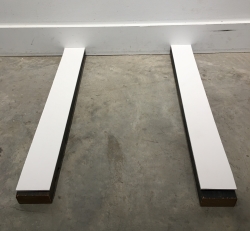
Using Risers to Raise Artwork Above the Floor Level
To determine the length of the risers that will keep the artworks off the floor, let’s say they are 2 x 4 boards, add up all the depth measurements on the cards you anticipate will be in the largest stack and add 12 inches to account for the separators if you are planning to use them. Also consider the angle against the wall of the first artwork in the stack. It does not matter if the boards are a bit too long, you just don’t want them to be too short. The risers should be placed perpendicular to the wall and far enough apart so the smallest artwork in the stack will sit on top of them. If the frames are fragile, you may want to cut two 3.5-inch strips off one of your separators and place it on the 2 x 4 risers before you start stacking artworks.
General Rules for Stacking


As a general rule, artworks should be stacked in a graduated order with the largest against the wall and the smallest being the last work added. If the first work placed is facing the wall and it is backed or has stretcher braces, it may have a smaller work stacked against it.

If the artwork is not backed or has stretcher braces, each new work that is added to the stack, whether using sheet separators or not, should either match or exceed its predecessor in either height or width, not both. This way, it will span an unprotected canvas and have at least two points of contact at the top, or upper sides of its frame.
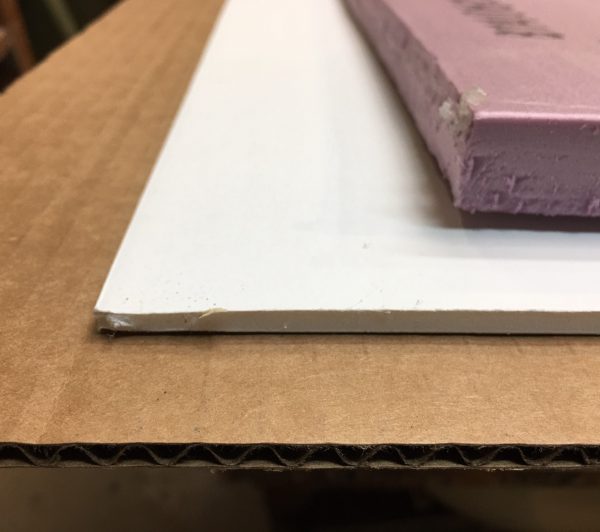
Using Separator Sheets to Protect Artworks
As mentioned above, it is always best to use separators between each artwork in a stack. I would recommend sheets of fluted cardboard, foam core, sheet insulation or other type of light stiff separator material. For each artwork added to the stack, place a separator sheet that is larger than the work it is placed in front of. That does not mean that it needs to be cut down to fit, it just means that the sheet should not be smaller.
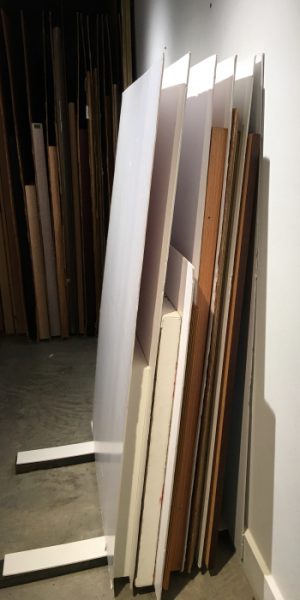
Note: Do not use soft materials to cover or wrap artworks such as blankets or sheets unless they are all glazed and backed works. Cotton blankets would be preferred over wool, especially if the artworks are pastels. Pastels should never be stored with their faces at a forward angle or face down. It would be best to place a glazed pastel, face up, on a bed.
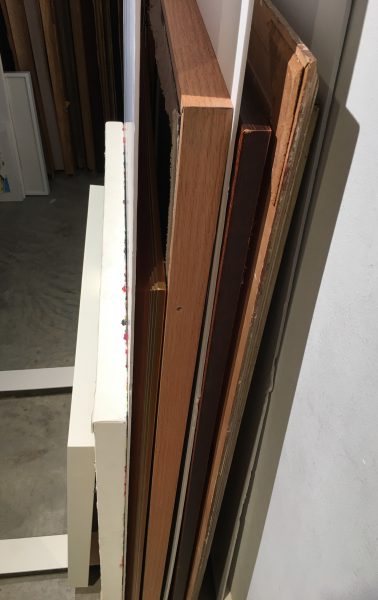
If you have more artworks than separator sheets, the face-to-face, back-to-back method of stacking may be appropriate. That means you should start your stack with a separator sheet against the wall and then place the first artwork, so it faces the wall and the top of its frame is in contact with the separator sheet and not with the wall. The second artwork should be placed, using the “at least two points of contact” rule, with its back to the first work. Then place a separator sheet against the face of the second work and repeat the process.

Stacking Without Separator Sheets
If you are planning on stacking without separator sheets, certainly not recommended by me, you have to be extra careful how and where each artwork makes contact with the artwork in front and behind it, and the “at least two points of contact rule” needs to be strictly adhered to. Also, if their weight and center of gravity is not a problem, they should, in most cases, be stacked face-to-face and back-to-back. When stacking, the artworks that are placed back-to-back should be touching all around. The works that are stacked face-to-face should not touch except at two upper points of contact. Where the frames touch, two folded washcloths can be used as protection by laying them over the frame where the contact is made.
Note: While works are stacked this way, they should remain undisturbed until they are unstacked to be reinstalled. Do not pull several works in the stack forward to show off a work, and under no circumstances pull a work from the center of the stack. If a work is needed, carefully unstack the works back to that artwork.
The Issue of Weight
Weight is a factor that may determine how many works should be in each stack. Large glazed works with heavy frames weigh a lot. You may not want to place any more than three or four works in a stack of artworks like this. Canvases with strip molding may not weigh a lot and therefore it might be realistic to stack more. Bottom line; you don’t want to stack so many artworks together that a single person could lose control of it if they were supporting it while another person was flipping through the artworks.
Determining an Artwork’s Center of Gravity
You will need to determine the center of gravity for the first artwork that starts a stack and ideally, each artwork that follows as they are placed. This can be determined by setting each artwork vertically on the floor in the orientation it will be stacked. It will normally want to fall forward or back depending on its center of gravity. (Whichever way it wants to fall, that is the side that should face the wall.) This means that if you are using separators between each artwork, they should be stacked in the direction that they would naturally fall. Works that do not easily fall one way or the other have a neutral center of gravity so they can be safely stacked either way.

Properly Setting the Angle of the First Artwork
The angle at which the first artwork is placed against the wall in a stack is very important! If the angle is too little, even if you have determined that its center of gravity will tend for it to naturally hug the wall, it sets up a situation where if other artworks are not stacked properly, it could allow the stack to fall. On the other hand, if the angle is too much, it will place undue stress on the stack because with every degree of extra angle added, the stack becomes progressively heavier with the first artwork that started the stack bearing the greatest weight. Also, instead of the possibility of the artworks that are stacked with too narrow an angle falling over, too much of an angle could cause the artworks at the end of the stack to start sliding out from the bottom. Also, the change of angle related to the height of the artwork also must be considered.
It is best to keep these issues in mind when determining how far the bottom of the first artwork should be away from the wall when setting the stack. Unfortunately, there is no formula that I know of that is a standard rule of thumb to determine the perfect angle, especially with all the unknown variables when you start. So, the best I can do is let you know how I do it:
I place the top of the first artwork so the side to which it naturally wants to fall is against the separator sheet that is leaning against the wall and its bottom is sitting on the riser about 4 inches away from the wall. I then pull the top of the artwork away from the wall about an inch to feel the weight of its resistance. If it seems too little, I will move the artwork’s bottom away from the wall another inch and try again until it feels right. If it seems like it is heavy or has too much resistance, I would move the artwork’s bottom toward the wall an inch and try again until the resistance feels right. Then I continue stacking other artworks between separators until I think stacking more would endanger the first artwork or make the stack unstable. I test the resistance of each added artwork as it is placed to be sure it is properly weighted towards the previously stacked work.
I focused on a guest bedroom as a good place to store artworks for this post because most guest bedrooms are properly climate controlled and rarely entered, making them an ideal location for storing artwork. Remember, because of change orders or unexpected issues that pop up during most any renovation project, they are rarely finished on time. For this reason, it is best to store your artworks where they will not be disturbed until they are ready to be put back on the wall. Having to unstack the artwork and move it to a safer location and then restack it will unnecessarily put the artwork in danger.
I hope you have found the information in this post helpful. Although I have mentioned a way to stack the artworks without using separators, I recommend using them. They will provide a higher level of protection to both the artwork and frames, especially if there is a situation where the stack falls over for some reason.
If your storage needs exceed the short term, you may have interest in reading my post, Four Artwork Storage Solutions. In the meantime, happy stacking.
*****
To see all available FAE Design Blog Posts, jump to the Design Blog Table of Contents.
To see all available FAE Collector Blog Posts, jump to the Collector Blog Table of Contents.
Sign up with FAE to receive our newsletter, and never miss a new blog post or update!
Browse fine artworks available to purchase on FAE. Follow us on Facebook, Instagram, or Twitter to stay updated about FAE and new blog posts.
For comments about this blog or suggestions for a future post, contact Kevin at [email protected].
Other FAE informational posts you may find helpful:
Fine Art Insurance 101
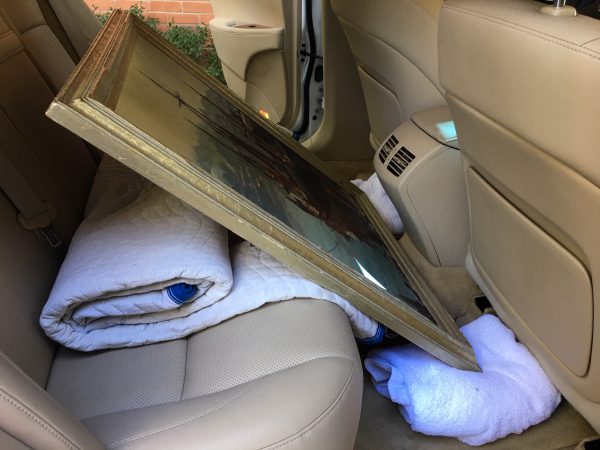 Practical Tips for Safely Transporting Artwork
Practical Tips for Safely Transporting Artwork
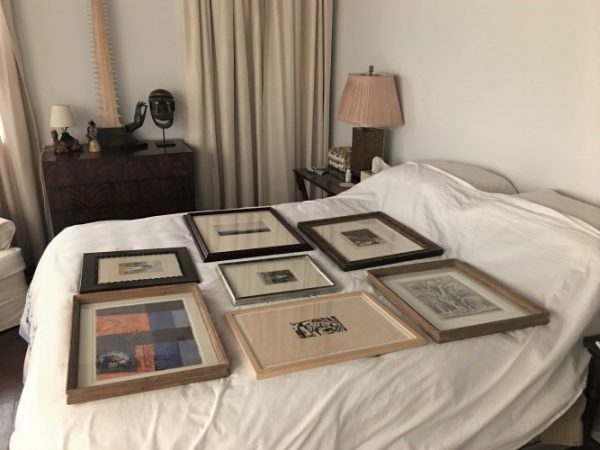 Temporarily Storing Artwork: A Case Study
Temporarily Storing Artwork: A Case Study
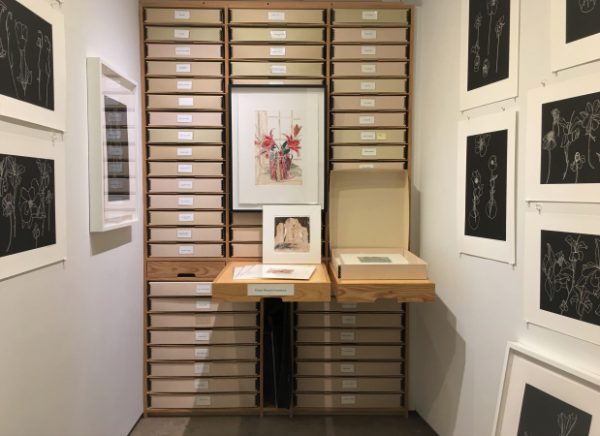 Four Artwork Storage Solutions
Four Artwork Storage Solutions
 Hanging and Framing FAQ’s
Hanging and Framing FAQ’s
 Siting Sculpture, Part One: Overview
Siting Sculpture, Part One: Overview
 Siting Sculpture: Part Two, A Case Study
Siting Sculpture: Part Two, A Case Study
 The Importance of a Proper Frame
The Importance of a Proper Frame
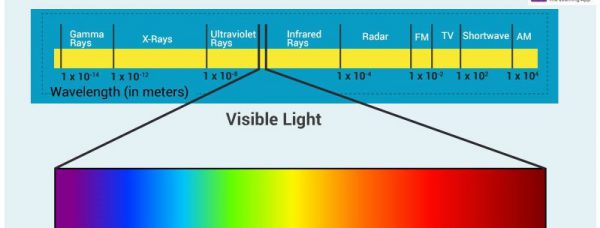 When to Use UV Control Glazing
When to Use UV Control Glazing
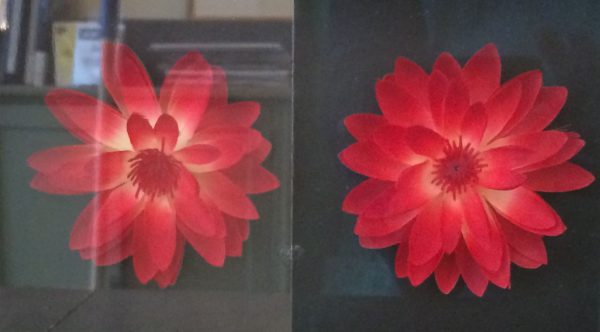 Reflection on the Problem of Reflections
Reflection on the Problem of Reflections
